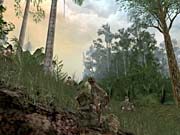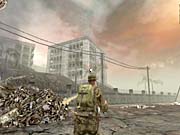The first Deadly Dozen was a budget-priced World War II-themed tactical shooter that, despite some problems, was surprisingly good. Almost exactly a year after its release, developer nFusion has released a follow-up, Deadly Dozen: Pacific Theater. As the title implies, the sequel moves the setting from North Africa and Western Europe to the jungles and cities of the Pacific campaign. It also improves on the original in every way--it's longer, it's better looking, it includes a multiplayer component, and it addresses several of Deadly Dozen's most serious problems. It has a few notable problems, but Pacific Theater stands on its own merits as a unique and entertaining shooter with a skillfully realized jungle setting.

Even though they share similar themes, Pacific Theater's design is almost a complete reversal of the design of the recently released Medal of Honor Allied Assault: Spearhead. While Spearhead presents you with what amounts to a heavily scripted, interactive amusement park ride, Pacific Theater sets you down in a series of huge environments, gives you a set of goals, and then pretty much leaves everything else up to you. You can choose your equipment and your team, the order in which you tackle the mission objectives, and what routes you take through the level.
Before each of the 12 large missions, you choose a squad of up to four soldiers out of a roster of a dozen. Each man has 11 attributes, up from Deadly Dozen's seven. But just like in the first game, unless you're planning on performing some sort of stunt course through the mission--like completing it armed only with a knife--the sniping and infiltration skills rule the battlefield. Some of the new weapons such as the samurai sword and a good-looking flamethrower are nice additions, but they're relatively useless.
This is largely because Pacific Theater, even more so than the original Deadly Dozen, is a game about creeping around and killing enemies from a distance. Thankfully, the environments and enemy AI make this style of play extremely satisfying. Pacific Theater's jungle environments are its most impressive feature. The levels are enormous--most appear to encompass perhaps two or three square miles of terrain. The diversity, density, and constant swaying motion of trees and undergrowth create a jungle atmosphere that's entirely believable. The fog curtain that plagued Deadly Dozen has been pushed back a little, but it's still around. As in the original, you won't be getting any panoramic views of your surroundings. However, the haziness seems more appropriate in the thick tropical foliage of Pacific Theater than it did in the bright sunlight of Deadly Dozen's desert levels.
Unlike Deadly Dozen's superhuman enemy AI, the enemy AI in Pacific Theater is no longer infallibly accurate and can no longer see you while it's still shrouded in fog. As a result, fog isn't a gameplay problem anymore. And as such, your computer-controlled teammates are actually an asset rather than the liability they often were in the original. Instead of waiting until one of their squadmates gets shot in the head from afar to take any action, in Pacific Theater, your teammates will often spot enemies and fire on them first.
But in general, the teammate AI is the area in which Pacific Theater is least improved. You can still give your squad basic commands such as "follow," "hold position," and "hold fire," but as in the first game, their pathfinding skills aren't especially refined. Sometimes, teammates will easily navigate a thick maze of logs and rocks. Other times, they'll get stuck behind a single boulder sitting by itself in the middle of an open stretch of flat ground. Their behavior is pretty unpredictable, which makes the problem more annoying. Since you can still actively control every member of your squad and manually guide them where you need them to go, it's not as big a problem as it could be, but it's still something that the developer should address if it plans to develop a Deadly Dozen 3.
The Pacific missions range from blowing up a bridge in Guadalcanal and infiltrating a Japanese airbase to destroying tanks roaming the streets of occupied Manila. One mission even takes place in the snowy Aleutian Islands, a setting overlooked by other World War II-themed games. Most levels feature a drivable vehicle or two, such as scout cars, transport trucks, and fully operational tanks, though you'll spend most of your time on foot. Unlike some games that have featured similar jungle settings, Pacific Theater's well-rendered environments actually provide believable cover for both you and your opponents, lending every mission a tangible element of paranoia. The game makes leaving the relative safety of lying on your belly in the weeds in order to sprint across an open field a legitimately thrilling gamble.
Even though the game's orchestral music score is excellent, you may want to turn it off for the simple reason that it occasionally intrudes on the gameplay. A "suspense" theme plays when enemies are near and stops when they're either gone or killed. This may work great for games that are less interactive, or for shooters that involve less use of camouflage, but it undercuts a lot of the tension the game works hard to build.

By far, Deadly Dozen's best (and most stable) multiplayer feature is the ability to play through the single-player levels cooperatively. With two or three players, the co-op mode works pretty smoothly. But as more players join a game, the server stability appears to take a serious nosedive. This makes Pacific Theater's other multiplayer modes (including deathmatch, capture the flag, and an interesting version of the single-player levels in which one team takes the Japanese side in an attempt to keep the American team from completing the mission goals) largely exercises in getting disconnected every two minutes. A patch is evidently in the works, but if you're planning to purchase Pacific Theater just for online deathmatch, you might want to hold off for a while.
There's a lot to like about Pacific Theater, not the least of which is its budget price. It's a little rough around the edges, but it's both exciting and technically impressive enough to hold its own against its full-priced competition.